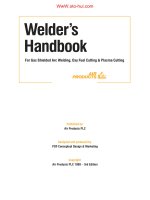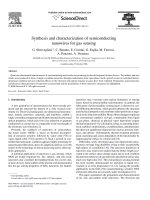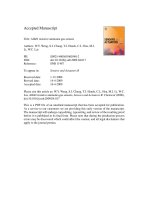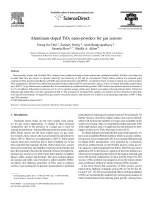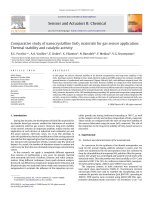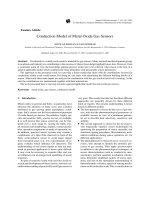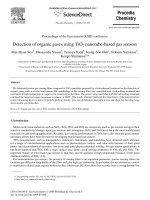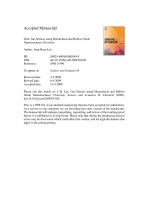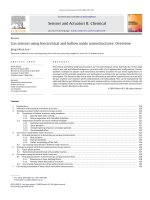- Trang chủ >>
- Khoa Học Tự Nhiên >>
- Vật lý
aluminum-doped tio2 nano-powders for gas sensors
Bạn đang xem bản rút gọn của tài liệu. Xem và tải ngay bản đầy đủ của tài liệu tại đây (783.97 KB, 7 trang )
Sensors and Actuators B 124 (2007) 111–117
Aluminum-doped TiO
2
nano-powders for gas sensors
Young Jin Choi
a
, Zachary Seeley
a
, Amit Bandyopadhyay
a
,
Susmita Bose
a,∗
, Sheikh A. Akbar
b
a
School of Mechanical and Materials Engineering, Washington State University, Pullman, WA 99164, United States
b
Department of Materials Science and Engineering, Ohio State University, Columbus, OH 43210, United States
Received 4 July 2006; received in revised form 4 December 2006; accepted 4 December 2006
Available online 30 January 2007
Abstract
Nano-powders of pure and Al-doped TiO
2
ceramics were synthesized using a citrate–nitrate auto combustion method. Powders were then used
to make thick film gas sensors to measure selectivity and sensitivity in CO and O
2
environment. Titanyl nitrate solution was prepared using
commercial TiO
2
powder, hydrofluoric acid (HF) and concentrated nitric acid (HNO
3
). An optimized ratio of citrate to nitrate was used to produce
TiO
2
nanoparticles. Powder X-ray diffraction data showed that synthesized TiO
2
nano-powders, pure as well as Al-doped, had stable anatase phase
up to 800
◦
C. X-ray fluorescence confirmed the Al concentrations in synthesized nano-powders. BET surface area analysis showed a decrease at
5 wt.% Al addition, followed by an increase at 7.5 wt.% in specific average surface area. Particle size analysis showed particles below 100 nm for
both pure and doped TiO
2
even after calcination at 800
◦
C. The resistance of Al-doped TiO
2
samples was found to be lower than that of pure TiO
2
in O
2
and CO environment. Al-doped TiO
2
gas sensors were more selective and sensitive to CO and O
2
at an operating temperature of 600
◦
C than
pure TiO
2
powders.
© 2007 Published by Elsevier B.V.
Keywords: Ceramic gas sensors; Gas sensitivity; Selectivity; Nano-powders; Titania
1. Introduction
Transition metal oxides are the most widely used ceram-
ics for gas sensor applications. A change in their electrical
conductivity due to the presence of a target gas is used for
sensing measurement. Among different transition metal oxides,
SnO
2
-based sensors are the most widely used. As gas sensi-
tive resistors, these sensors show good sensitivity and selectivity
below 250
◦
C. However, at temperatures >250
◦
C, SnO
2
-based
sensors show poor sensitivity due to lack of stability [1].Ithas
been reported that titanium dioxide (TiO
2
)-based gas sensors
show good sensitivity and stability in adverse environments and
have the potential to become the material of choice for high tem-
perature gas sensors [2,3].TiO
2
forms three distinct crystalline
phases: rutile, anatase and brookite. The most common phases
are anatase and rutile, since brookite is rather unstable. Differ-
ent phases also influence properties of TiO
2
such as catalytic
activity or gas sensing [4]. In general, anatase phase is preferred
∗
Corresponding author. Tel.: +1 509 335 7461; fax: +1 509 335 4662.
E-mail address: (S. Bose).
particularly for reducing environment such as CO sensing [5].To
further increase sensitivity, higher surface area can be utilized,
which will increase the number of oxygen sites available on the
surface for sensing. Thus, it is hypothesized that nanoscale TiO
2
with a high surface area to weight ratio has the potential to show
higher sensitivity for TiO
2
-based gas sensors [6,7].
To obtain optimum and reproducible nanosized materials, we
have used a modified Pechini method, which is an auto combus-
tion process at low temperature [8]. It was reported that pure and
Ce-doped SnO
2
nanoparticles were prepared by a polymeric
precursor method based on the Pechini process using tin cit-
rate aqueous solution prepared from SnCl
2
·2H
2
O for gas sensor
application [9]. In this process, ignition of the resin initiates at a
relatively low temperature that removes the organic material, and
leaves the desired compositions in nano-powder form [10]. The
success of this synthesis encouraged us to use the citrate–nitrate
auto combustion method to obtain nanosized TiO
2
powders.
It has been shown that sensitivity of TiO
2
sensors can be
improved by addition of dopants such as Nb, Cr, Sn, Pt, Zn, Al,
La and Y [11–17]. The most important effects of dopant addition
in TiO
2
are increasing the conductivity, slowing down anatase to
rutile transformation and reducing grain growth. Among those
0925-4005/$ – see front matter © 2007 Published by Elsevier B.V.
doi:10.1016/j.snb.2006.12.005
112 Y.J. Choi et al. / Sensors and Actuators B 124 (2007) 111–117
dopants, Al-doping in TiO
2
shows retardation of phase transfor-
mation from anatase to rutile by stabilizing the surface state of
TiO
2
particles and also inhibits grain growth [18]. It has been
reported that the conductivity of the Al-doped TiO
2
is higher
than that of pure TiO
2
in a temperature range of 600–900
◦
C
[19]. Since ionic radii for Al and Ti are close to each other
(0.074 nm for Ti
4+
and 0.0675 nm for Al
3+
) [20], Al can occupy
a regular cation position, forming a substitutional solid solu-
tion. To maintain electrical neutrality, such substitutions will
create oxygen vacancies and donate electrons to make it an n-
type semiconductor [21]. Dopant addition in TiO
2
also enhances
sensitivity and selectivity towards certain gasses. It has been
reported that sputteredfilms of TiO
2
, principally anatasein struc-
ture, are highly selective towards hydrogen gas [22]. Moreover,
Al-doped TiO
2
and ZnO ceramics have also been shown to have
higher sensitivity to humidity in thick and thin films [23,24].
In this study, TiO
2
nano-powders have been synthesized with
0, 5 and 7.5 wt.% of Al-doping and calcined at 700, 800 and
900
◦
C. Phase stability, powder particle morphology and elec-
trical properties of nanosized Al-doped TiO
2
were characterized
focusing on gas sensing application.
2. Experimental procedure
All samples were synthesized using commercial TiO
2
pow-
ders (Santa Fe Springs, CA, Dupont). Commercial TiO
2
powder
was kept for 4 days in HF to prepare a Ti solution. After 4 days,
the liquid part was taken out by filtering the mixture using an
11 m filter paper. Ammonium hydroxide (NH
4
OH) was added
to the filtered liquid for complete precipitation at pH between
10 and 11. The precipitate was washed using distilled water and
then dissolved in concentrated nitric acid (HNO
3
). Citric acid
was then added to this precursor mixture with a citrate to nitrate
ratio (C/N) of 0.5. An aqueous solution of Al(NO
3
)
3
was added
to this solution as a dopant. The solution was heated on a hot
plate, and after complete gelation, hot plate temperature was
increased to 350
◦
C for complete drying. Final calcination was
done in an alumina crucible at 700, 800 and 900
◦
C for 1 h. TiO
2
nano-powders were characterized for phase analysis using X-ray
diffraction (Philips PW 3040/00 Xpert MPD) at room tempera-
ture using Co K␣ radiation with a Ni-filter. XRD studies were
carried out over a 2θ range from 20
◦
to 70
◦
at a step size of
0.02
◦
(2θ) and a count time 0.5 s per step. d-Spacing shifts of
the (1 0 1) and (2 0 0) peaks were analyzed over a 2θ range of
3
◦
and a step size 0.01
◦
s
−1
. To calculate the d-spacing, the cen-
ter angle for each peak was calculated based on the center at
half the maximum intensity. Compositional analysis using X-
ray fluorescence (Philips 1600/10) was performed on pure and
Al-doped samples calcined at 800
◦
C. Powder surface area was
measured using a five point BET surface area analyzer (Tristar
3000, Micromeritics, GA). Transmission electron micrographs
were taken on a Jeol JEM120 electron microscope. A particle
size analyzer (Nicomp 380, Santa Barbara, CA) was used to
measure particle size of the synthesized powders.
For conductivity measurement, thick film samples were pre-
pared on an Al
2
O
3
substrate with interdigitated Pt electrodes.
Two holes connected with the interdigitated Pt electrode in the
alumina substrate were connected with silver wires as leads. To
further improve contacts, the holes were coated with gold pastes
after connecting the silver wires. For thick film preparation,
alpha teripineol was used as a solvent, which was ultrasoni-
cated to mix thoroughly with the synthesized powders and then
deposited drop by drop on top of the electroded alumina sub-
strate. The films were then dried in an oven at 100
◦
C, followed
by partial densification at 800
◦
C for 1 h in a muffle furnace.
Thick film samples were tested in a tube furnace at 600
◦
Cas
a function of CO and O
2
concentration in background gas of
10 vol% O
2
and 90 vol% N
2
. The gas flow rate was controlled
with flow meters, and for all of these tests, the total gas flow
rate was fixed at 150 cm
3
min
−1
. Air, pure nitrogen and CO
gases were allowed to mix during their passage to the test setup.
Before electrical measurements, gas flow was calibrated using
an optic flow meter. Also before any measurement, the sam-
ple was allowed to stabilize, up to 1 week, to generate a steady
background resistance. A small drift in the electrical resistance
was there in most of our measurements, but an acceptable con-
dition was arbitrarily used as maximum allowable variation of
±0.01 M h
−1
in resistance.
3. Results
Compositional X-ray fluorescenceanalysis, shown in Table 1,
confirmed that the aluminum concentration did not decrease as a
result of diffusion, sublimation or evaporation during the synthe-
sis or calcination processes. Some alumina was already present
as an impurity in the starting reagent material and was trans-
ferred during synthesis into the final powder product. Additional
Al in the form of dopant can be seen to increase the Al com-
position above that of the original impurity. X-ray diffraction
results revealed that the amount of Al dopant as high as 7.5 wt.%
had no significant effect on the anatase phase (JCPDS 00-002-
0387) formation of nano-TiO
2
powders calcined at 800
◦
C for
1 h, as shown in Fig. 1. No peaks related to Al or Al
2
O
3
were
detected, suggesting that Al is not forming a significant sec-
ond phase. Upon analyzing (1 0 1) and (2 0 0) peak shifts, seen
in Fig. 2 and Table 2, we have found that with addition of Al
the d-spacing decreases by approximately 0.5% for both peaks
due to the smaller atomic size of Al. This data suggests that
some Al is going into the TiO
2
crystal lattice as a substitutional
atom. However, upon increasing the content of Al there is little
additional shift in the d-spacing. This suggests that the excess
Al is likely precipitating as an alumina-based secondary phase
that is probably a glassy phase or too small to be detected by
Table 1
Influence of Al-doping on the atomic composition of TiO
2
powder calcined at
800
◦
C
Sample Compositional X-ray fluorescence analysis (wt.%)
TiO
2
Al
2
O
3
Na
2
O SiO
2
K
2
O CaO
Pure TiO
2
91.4 7.2 1.07 0.24 0.05 0.04
5 wt.% Al-doped 88.9 12.4 0.87 0.44 0.04 0.03
7.5 wt.% Al-doped 86.3 14.9 0.74 0.44 0.03 0.05
XRF analysis can give up to ±2.5 wt.% variation in compositional analysis.
Y.J. Choi et al. / Sensors and Actuators B 124 (2007) 111–117 113
Fig. 1. Powder X-ray diffraction patterns for different Al-doped TiO
2
after heat
treating at 800
◦
C1h.
Fig. 2. Influence of Al doping on the powder X-ray diffraction anatase (1 0 1)
peak shift for powders calcined at 800
◦
C.
Table 2
Influence of Al-doping on the anatase (1 0 1) and (2 0 0) d-spacing shifts for
powders calcined at 800
◦
C
Sample (hkl)-Values
(101) (200)
d-Spacing (
˚
A) Shift (%) d-Spacing (
˚
A) Shift (%)
Pure TiO
2
3.5215 0 1.8994 0
5 wt.% Al-doped 3.5113 0.29 1.8890 0.55
7.5 wt.% Al-doped 3.4964 0.71 1.8887 0.56
XRD. From X-ray diffraction data, crystallite size is calculated
via measuring the peak broadening using Scherrer’s equation
[25] and is shown in Table 3. It is found that higher calcina-
tion temperature increased the crystallite size. With increasing
Al dopant concentration, there is an initial increase in crystallite
size up to 5 wt.%, followed by a decrease at 7.5 wt.% Al. Table 3
also shows particle size distribution of TiO
2
nano-powders heat
treated between 700 and 900
◦
C for 1 h. At 700
◦
C, average par-
ticle size remains below 100 nm for all compositions; however,
particle size increases with increasing calcination temperature.
Particle size also varies with Al concentration in a similar man-
ner as crystallite size, an initial increase up to 5 wt.%, followed
by a decrease at 7.5 wt.% Al. Table 3 also shows particle size
calculated from specific average surface area, assuming non-
porous spherical powders, as a function of dopant concentration
and calcination temperature. Similar to particle and crystallite
sizes, surface area decreased, i.e., particle size increased with
increasing calcination temperature. The 7.5 wt.% Al concentra-
tion shows higher surface area for all calcination temperatures;
however, a drop at 5 wt.% Al is also seen. The highest surface
area of 25 m
2
/g is observed for the pure TiO
2
powders calcined
at 700
◦
C for 1 h. TEM images for TiO
2
nano-powders with dif-
ferent Al concentrations calcined at 800
◦
C are shown in Fig. 3.
TEM micrographs show the particle size between 30 and 80 nm
for pure and doped TiO
2
. The aspect ratio of the powders varied
between 1 and 3 and was not significantly affected by the Al
addition.
The impurity concentration and chemistry in semiconducting
metal oxides control their electrical resistance, since extrin-
sic defect contribution is significantly higher than the intrinsic
defects. XRD data suggests that Al ions dissolve substitution-
ally in the TiO
2
lattice because of the similar ionic radius to Ti
[26], then oxygen vacancies are expected to generate [27] and
the defect equation with charge conservation can be written as:
Al
2
O
3
2TiO
2
−→ 2Al
Ti
+ 3O
×
O
+ V
O
••
(1)
The presence of oxygen vacancies will increase the conductivity
of the solid. Further increase in conductivity is expected under
low oxygen partial pressure, due to generation of more oxygen
vacancies and can be written as
TiO
2
→ Ti
Ti
+ V
O
••
+
1
2
O
2
(g) + 2e
(2)
It has been reported that the conductivity of the Al-doped TiO
2
is an order of magnitude higher than that of pure TiO
2
between
600 and 900
◦
C [28].
Fig. 4 shows a typical resistance measurement plot as a func-
tion of CO concentration at 600
◦
C with a background gas of
5 vol% O
2
/95 vol % N
2
. It can be seen that with increasing CO
concentration, resistance decreases or conductivity increases.
Table 3
Influence of Al-doping on the surface area, particle size and crystallite size of TiO
2
calcined at different temperatures between 700 and 900
◦
C for 1 h
Dopant content 700
◦
C 800
◦
C 900
◦
C
Particle size (nm) Crystallite size
from XRD
Particle size (nm) Crystallite size
from XRD
Particle size (nm) Crystallite size
from XRD
(nm)
From BET;
surface area
(m
2
/g)
From
TEM
From BET;
surface area
(m
2
/g)
From
TEM
From BET;
surface area
(m
2
/g)
From
TEM
Pure TiO
2
60.1 (24.96) 41.0 26.2 62.7 (23.91) 39.0 32.1 134 (11.18) 50 37.0
5 wt.% Al-doped 79.6 (18.84) 53.0 32.6 106 (14.09) 42.0 37.1 295 (5.09) 87 44.8
7.5 wt.% Al-doped 66.6 (22.51) 44.0 26.2 79.5 (18.87) 41.0 28.7 220 (6.83) 76 41.2
114 Y.J. Choi et al. / Sensors and Actuators B 124 (2007) 111–117
Fig. 3. TEM micrographs of TiO
2
powder sample after calcining at 800
◦
C for
1 h with Al doping. (a) Pure TiO
2
powder, (b) 5 wt.% Al and (c) 7.5 wt.% Al in
TiO
2
.
The effective resistance can then be compared with the back-
ground resistance as R/R
o
, where R is the resistance in the
target gas and R
o
is the background resistance. Fig. 5 shows
the response of pure and doped TiO
2
as a function of oxygen
concentration at an operating temperature of 600
◦
C. The oxygen
concentration has been varied from 2 to 10% and the response
Fig. 4. Resistance as a function of CO concentration for 7.5 wt.% Al-doped
TiO
2
at 600
◦
C in a background gas of 5 vol% O
2
/95 vol% N
2
.
was measured in terms of change in resistivity of the thick film
sensor. In these measurements, a background gas of 10 vol%
O
2
/90 vol% N
2
was used. During resistance measurements, O
2
concentration was decreased down to 2%. The response to the
gases is plotted as a relative resistance R/R
o
. With increasing
oxygen concentration, the relative resistance decreases, i.e., the
value of R/R
o
is approaching 1. In these results, pure TiO
2
showed no distinct difference in oxygen gas sensing with a
change in calcination temperature, but 5 and 7.5 wt.% Al-doped
TiO
2
showed an increase in response at low O
2
concentration for
powders that were calcined at 900
◦
C. Among 900
◦
C samples,
5 wt.% Al-doped TiO
2
showed the highest response of 0.94 at
2% oxygen concentration.
Fig. 6 shows the response to different CO concentrations of
pure and Al-doped TiO
2
calcined at various temperatures. All
samples show n-type behavior, i.e., increasing conductivity with
increasing CO concentration due to generation of electrons. The
n-type behavior can be explained based on the concentration of
oxygen vacancies shown in Eq. (2) [3,16]. The 5 wt.% Al-doped
TiO
2
calcined at 900
◦
C shows the highest response among all
the samples. At 0 and 5 wt.% Al concentration, higher calci-
nation temperature samples show higher response. However, at
7.5 wt.% dopant concentration, there is no significant difference
in CO gas sensing at various calcination temperatures.
4. Discussion
Our results clearly show that Al addition to TiO
2
influences
the crystallite and particle sizes, response or resistance change
in different gas environments, but has no effect on phase
formation. In all cases, anatase phase is formed with or without
Al dopants. Due to similar ionic radii, it is hypothesized that Al
will substitute for Ti in the cationic site, resulting in a charge
imbalance. Substitutional defects will cause a slight decrease
in d-spacing, evident from our XRD data, due to the difference
in atomic size. To balance the electronic charge, it is also
hypothesized that oxygen vacancies are created, which then
modifies the response under different gas environments. To
Y.J. Choi et al. / Sensors and Actuators B 124 (2007) 111–117 115
Fig. 5. Response to different oxygen concentrations of: (a) pure, (b) 5 wt.% and
(c) 7.5 wt.% Al-doped TiO
2
, calcined at 700, 800 and 900
◦
C at an operating
temperature of 600
◦
C.
further understand our hypothesis, we have heat treated 5 and
7.5 wt.% Al powders up to 1100
◦
C to observe any secondary
phase formation at a higher crystallinity. All samples show
rutile phase formation. No separate peaks are observed to
indicate any other phases, suggesting that Al is dissolving in
the TiO
2
crystal lattice. It has been reported that dopants also
reduce grain growth. In this case, it can be seen that addition of
Al up to 5 wt.% has very little effect on grain growth; however,
at 7.5 wt.% Al, a reduction in particle size is clearly evident. A
similar trend is also seen in crystallite size data. Based on the
Fig. 6. (a–c) Response to different CO concentrations of undoped and Al-doped
TiO
2
calcined at 700, 800 and 900
◦
C in a background gas of 10 vol% O
2
balanced by N
2
at an operating temperature of 600
◦
C.
data, we conclude that some critical concentration of Al in TiO
2
is necessary to influence the crystallite size or grain size and
that the concentration is between 5 and 7.5 wt.% for Al in TiO
2
.
However, Al addition did not influence the particle morphology,
and in all cases low aspect ratio powders are formed.
From Eq. (1), it can be seen that Al doping increases the
n-type behavior of TiO
2
. Therefore, it is expected that under
high oxygen partial pressure, the conductivity of these materials
will decrease, while low oxygen partial pressure will increase
the conductivity. We have studied the influence of calcination
116 Y.J. Choi et al. / Sensors and Actuators B 124 (2007) 111–117
temperature and dopant concentration. Calcination temperature
will influence crystallization of these powders, while the dopant
amount will change the concentration of oxygen vacancies in
the starting material. Higher doping will also create higher dis-
order in the structure and may influence crystallization behavior.
Fig. 5a shows response of pure TiO
2
as a function of calcina-
tion temperature in oxygen environment. The 900
◦
C calcination
shows the best response, though the difference in response as a
function of calcination temperature is not very significant. The
difference can be attributed to higher crystallization of these
nano-powders at higher temperatures. Fig. 5b and c shows the
similar behavior for doped powders. Two significant differences
are observed: (1) at low calcination temperature, i.e., at 700
◦
C,
the response of pure TiO
2
is better than the doped powders, and
(2) at higher calcination temperature, the response of doped pow-
ders improves significantly. The poor low temperature response
can only be attributed to low crystallinity in the powders, which
improved with increasing calcinations temperature. Also, the
amount of Al dopant plays an important role in this effect;
for 5 wt.% dopant, the response started improving from 800
◦
C
onwards, while for 7.5 wt.% dopant composition, 900
◦
C is nec-
essary to improve the response. The best response is seen for
5 wt.% Al addition samples calcined at900
◦
C. It is hypothesized
that powders with higher dopant concentrations need higher
calcination temperature or longer calcination time to complete
crystallization andsee the influence of dopant on response.How-
ever, care needs to be taken to avoid any anatase to rutile phase
transformation with these powders during calcination. Fig. 6a–c
shows response in CO environment. Doped samples show higher
response and theresponse increased at a higher rate forpure pow-
ders as a function of calcination temperature—an effect that is
attributed to thecrystallization of these powders. For 7.5 wt.% Al
powder, almost no change in response is seen due to calcination
temperature. Creation of oxygen vacancies is more difficult in
CO environment than filling the vacant sites in an oxygen rich
environment. Moreover, CO response is also more dependent
on the surface conduction from adsorbed oxygen. As a result,
oxygen environment data show more influence towards calcina-
tion temperature and dopant concentration than CO environment
data. Overall, our results show that sensitivity and selectivity of
TiO
2
-based semiconducting oxide ceramics can be varied using
both chemistry and crystallinity in the powders.
5. Conclusions
Nano-powders of pure and Al-doped TiO
2
ceramics were
synthesized using a citrate–nitrate auto combustion method. X-
ray diffraction results showed that the amount of Al dopant, as
high as 7.5 wt.%, had no significant effect on the anatase phase
formation of nano-TiO
2
powders. Both particle and crystallite
sizes increased with increasing calcination temperature. At con-
stant calcination temperature, the amount of Al dopant initially
at 5 wt.% increased both particle and crystallite sizes and then
decreased themat 7.5 wt.%. It was found that the sensor response
increased in both oxygen and CO environments with increasing
calcination temperature for pure TiO
2
nano-powders. However,
for Al-doped powders, there was no linear relationship between
sensor response and calcination temperature. It had been hypoth-
esized that the variation in sensor response in Al-doped powders
as a function of calcination temperature was due to crystallinity
in the powders. With dopant addition, higher crystallinity was
also needed to improve sensitivity of these gas sensors.
Acknowledgements
Financial supports from the WSU Foundation, office of
research (OR) and the Office of Naval Research (Grant
#N00014-1-04-0644) are acknowledged.
References
[1] M. Radecka, K. Zakrzewska, M. Rekas, SnO
2
–TiO
2
solid solutions for gas
sensors, Sens. Actuators B: Chem. 47 (1998) 194–204.
[2] P.K. Dutta, A. Ginwalla, B. Hogg, B.R. Patton, B. Chwieroth, Z. Liang, P.
Gouma, M. Mills, S.A. Akbar, Interaction of carbon monoxide with anatase
surfaces at high temperatures: optimization of a carbon monoxide sensor,
J. Phys. Chem. B 103 (1999) 4412–4422.
[3] N. Savage, B. Chwieroth, A. Ginwalla, B.R. Patton, S.A. Akbar, P.K.
Dutta, Composite n–p semiconducting titanium oxides as gas sensors, Sens.
Actuators B: Chem. 79 (2001) 17–27.
[4] G.S. Devi, T. Hyodo, Y. Shimizu, M. Egashira, Synthesis of mesoporous
TiO
2
-based powders and their gas-sensing properties, Sens. Actuators B:
Chem. 87 (2002) 122–129.
[5] D. Qin, W. Chang, J. Zhou, Y. Chen, An investigation of the preparation
of TiO
2
-based catalysts using methods of thermal analysis, Thermochim.
Acta 236 (1994) 205–216.
[6] M. Ferroni, V. Guidi, G. Martinelli, G. Faglia, P. Nelli, G. Sberveglieri,
Characterization of a nanosized TiO
2
gas sensor, Nanostruct. Mater. 7
(1986) 709–718.
[7] H M. Lin, C H. Keng, C Y. Tung, Gas-sensing properties of nanocrys-
talline TiO
2
, Nanostruct. Mater. 9 (1997) 747–750.
[8] M.P. Pechini, Method of preparing lead and alkaline earth titanates and
niobates and coating method using the same to form a capactitor, US Patent
No. 3,330,697 (1967).
[9] P.A. Lessing, Mixed-cation oxide powders via polymeric precursors, Am.
Ceram. Soc. Bull. 68 (1989) 1002–1007.
[10] A.P. Maciel, P.N. Lisboa-Filho, E.R. Leite, C.O. Paiva-Santos, W.H.
Schreiner, Y. Maniette, E. Longo, Microstructural and morphological anal-
ysis of pure and Ce-doped tin dioxide nanoparticles, J. Eur. Ceram. Soc.
23 (2003) 707–713.
[11] M. Ferroni, M.C. Carotta, V. Guidi, G. Martinelli, F. Ronconi, O. Richard,
D. Van Dyck,J.Van Landuyt, Structural characterizationofNb–TiO
2
nano-
sized thick-films for gas sensing application, Sens. Actuators B: Chem. 68
(2000) 140–145.
[12] K. Zakrzewska, M. Radecka, M. Rekas, Effect of Nb, Cr, Sn additions on
gas sensing properties of TiO
2
thin films, Thin Solid Films 310 (1997)
161–166.
[13] A. Ruiz, J. Arbiol, A. Cirera, A. Cornet, J.R. Morante, Surface activation
by Pt-nanoclusters on titania for gas sensing applications, Mater. Sci. Eng.
C 19 (2002) 105–109.
[14] K.H. Yoon, J. Cho, D.H. Kang, Physical and photoelectrochemical prop-
erties of the TiO
2
–ZnO system, Mater. Res. Bull. 34 (1999) 1451–
1461.
[15] K. Hatta, M. Higuchi, J. Takahashi, K. Kodaira, Floating zone growth and
characterization of aluminum-doped rutile single crystals, J. Cryst. Growth
163 (1996) 279–284.
[16] N.O. Savage, S.A. Akbar, P.K. Dutta, Titanium dioxide based high tem-
perature carbon monoxide selective sensor, Sens. Actuators B: Chem. 72
(2001) 239–248.
[17] L.D. Birkefeld, A.M. Azad, S.A. Akbar, Carbon monoxide and hydrogen
detection by anatase modification of titanium dioxide, J. Am. Ceram. Soc.
75 (1992) 2964–2968.
Y.J. Choi et al. / Sensors and Actuators B 124 (2007) 111–117 117
[18] K.P. Kumar, K. Keizer, A.J. Burggraaf, Textural stability of titania–alumina
composite membranes, J. Mater. Chem. 3 (1993) 917–922.
[19] I. Sayago, J. Guti
´
errez, L. Ar
´
es, J.I. Robla, M.C. Horrillo, J. Rino, J. Getino,
J.A. Agapito, The effect of additives in tin oxide on the sensitivity and
selectivity to NO
x
and CO, Sens. Actuators B: Chem. 26 (1995) 19–23.
[20] M.W. Barsoum, Fundamentals of Ceramics, IOP Publishing, Bristol and
Philadelphia, 2003, pp. 80–83.
[21] W.D. Kingery, H.K. Bowen, Introduction to Ceramics, Wiley, New York,
1976, pp. 888–899.
[22] L.A. Harris, A titanium dioxide hydrogen sensor, J. Electrochem. Soc. Solid
State Sci. Technol. 127 (1980) 2657–2662.
[23] W P. Tai, J H. Oh, Humidity sensing behaviors of nanocrystalline Al-
doped ZnO thin films prepared by sol–gel process, J. Mater. Sci. Mater.
Electron. 13 (2002) 391–394.
[24] W P. Tai, J G. Kim, J H. Oh, Humidity sensitive properties of nanostruc-
tured Al-doped ZnO: TiO
2
thin films, Sens. Actuators B: Chem. 96 (2003)
477–481.
[25] B.D. Cullity, J.W. Weymouth, Elements of X-Ray Diffraction, second ed.,
Addison-Wesley, Reading, 1978, pp. 284–285.
[26] R.A. Slepetys, P.A. Vaughan, Solid solution of aluminum oxide in rutile
titanium dioxide, J. Phys. Chem. 73 (1969) 2157–2162.
[27] D.M. Smyth, The role of impurities in insultating transition metal oxides,
Prog. Solid State Chem. 15 (1984) 145–171.
[28] K. Hatta, M. Higuchi, J. Takahashi, K. Kodaira, Floating zone growth and
characterization of aluminum-doped rutile single crystals, J. Cryst. Growth
163 (1996) 279–284.
Biographies
Young Jin Choi joined the School of Mechanical and Materials Engineering
at Washington State University (WSU) in 2004 after receiving BS from South
Korea. He received his MS in Material Science and Engineering from WSU
which was focused on nanoscale TiO
2
synthesis and their use in gas sensors.
Currently he is working in South Korea.
Zachary Mark Seeley was born May 7th 1980. He received his BA in Math-
Physics from Whitman College in Walla Walla, WA in 2003. In 2005 he received
his MS inMaterialScience Engineering fromWashington State University which
was focused on mechanical properties of bioceramics. He is currently study-
ing for a PhD in Material Science at Washington State University working on
chemical gas sensors.
Amit Bandyopadhyay received his BS in Metallurgy from Jadavpur University
(Calcutta, India) in 1989, MS in Metallurgy from the Indian Institute of Science
(IISC-Bangalore, India) in 1992, and PhD in Materials Science and Engineering
from the University of Texas at Arlington in 1995. He worked as a research
associate at the Center for Ceramics Research at Rutgers University from 1995
to 1997 and joined the School of Mechanical and Materials Engineering at
Washington State University in 1997 as an Assistant Professor. He became an
Associate Professor in 2001 and a Professor in 2006. He is also the director
of the Bioengineering Research Center at WSU. His research interest lies with
processing and characterization of bio, piezoelectric, and structural materials.
He has received the Young Investigator Program Award from the Office of Naval
Research in 1998 and the CAREER award from the National Science Foundation
in 1999. He holds 8 US patents, published 120 technical articles, and edited one
book.
Susmita Bose received her BS in Chemistry (Honors) from the University of
Kalyani (India) in 1990, MS in Chemistry from Indian Institute of Technology
(IIT) Kanpur in 1992, and PhD in Physical Organic Chemistry from Rutgers-The
State University of New Jersey in 1998. Dr. Bose joined Washington State Uni-
versity (WSU) as a Research Assistant Professor in 1998. In 2001, she became an
Assistant Professor and in 2006 an Associate Professor in the School of Mechan-
ical and Materials Engineering. In 2002, Dr. Bose received the CAREER award
from the National Science Foundation and in 2004 she received the Presiden-
tial Early Career Award for Scientists and Engineers (PECASE) from the NSF.
Her research interest lies with synthesis and processing of materials with spe-
cial emphasis towards nanomaterials for bio-medical, piezoelectric and Sensor
applications. She is author and co-author of 75 technical articles.
Sheikh A. Akbar is a Professor of Materials Science and Engineering and
Founder of the NSF Center for Industrial Sensors and Measurements (CISM).
He obtained his PhD from Purdue University in 1985. His current research deals
with synthesis-microstructure-property relations of ceramic bulk, thin-film and
nano-structures for chemical sensing and catalysis.
